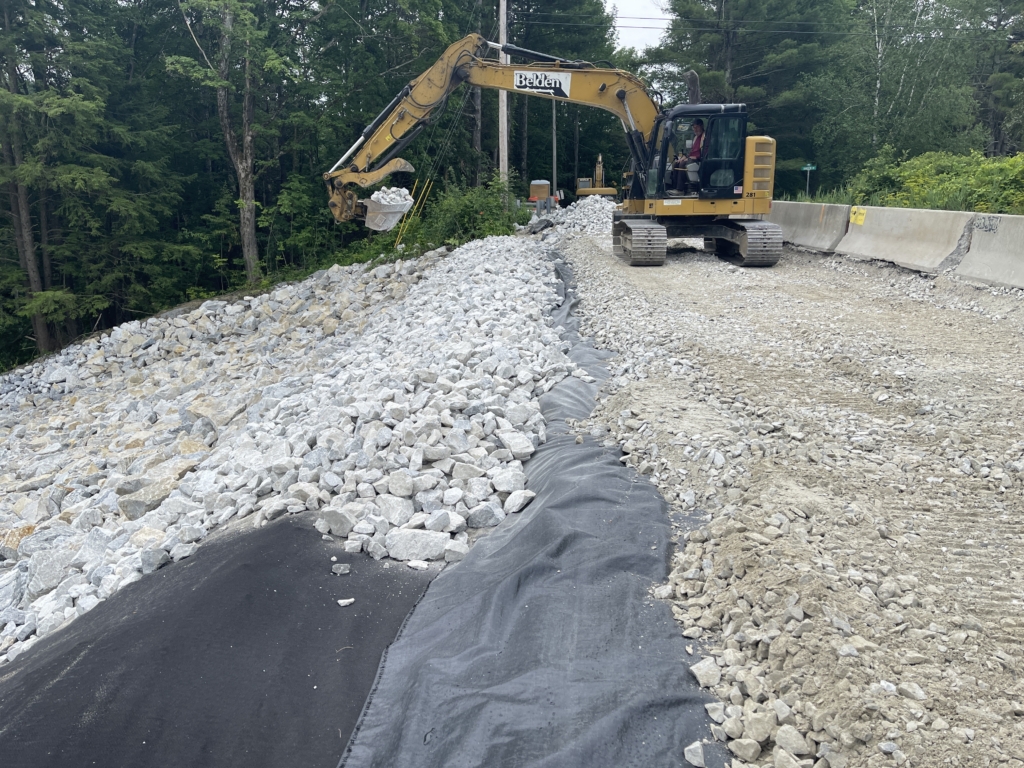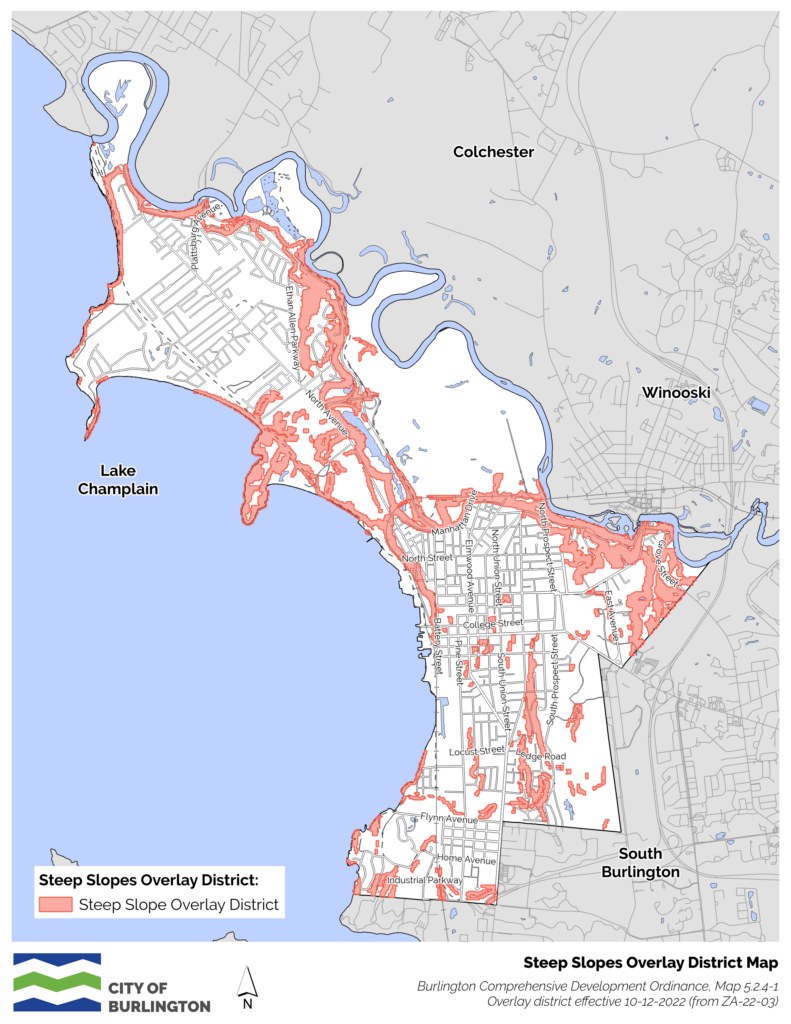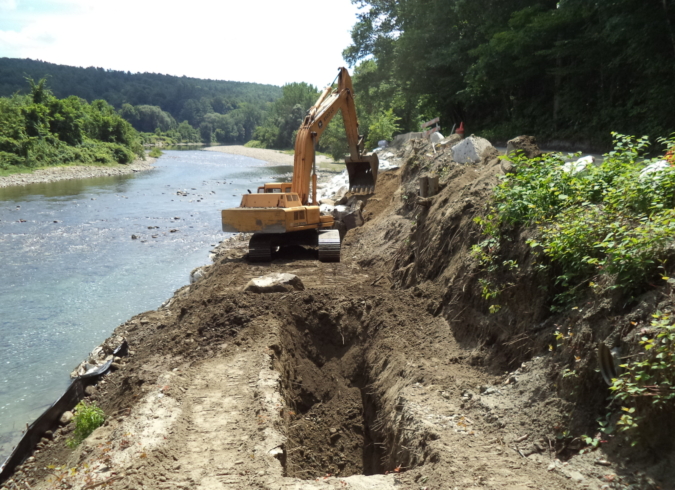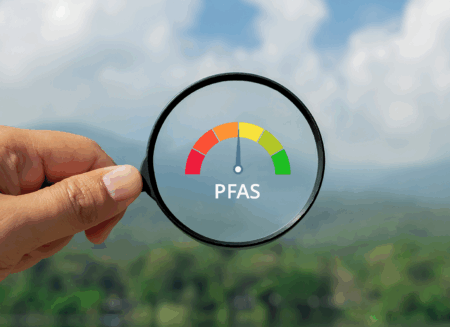Climate change has dramatically increased flooding issues, leading to frequent and intense storms that have overwhelmed Vermont’s infrastructure.
In recent years, the state has seen a sharp rise in extreme weather events, including flash floods that have devastated communities like the 2023 catastrophic floods and those in the Northeast Kingdom region. Some reports suggest 1-in-100-year events are now closer to 1-in-62-year events, putting a strain on emergency response resources and highlighting the need to address climate resilience in infrastructure.
While evaluating and designing slopes to ensure safe and stable conditions is a core service for geotechnical engineering firms, the growing implications of climate change have made more durable and climate-friendly solutions an increasingly important topic for the profession and the public at large.
Addressing Slope Stability with Resiliency in Mind
When faced with a slope failure, a geotechnical engineering firm with resiliency in mind will aim to understand why a slope failed in the first place and then design the repair under the assumption that the slope will encounter similar – and increasingly worse – external conditions in the future. Safety in design can be measured by calculating a design element’s Factor of Safety, and for slope stability analysis, the factor of safety is defined as the resisting force divided by the driving force. The resulting number describes the relative safety of the design: the higher the number of Factor of Safety, the safer the structure will be. When slope instability does not endanger the public (i.e., damage to dwellings), the target should be at least a Factor of Safety of 1.3, otherwise a Factor of Safety of 1.5 is used as provided by VTrans.
The final solution considers many factors – cost, federal or municipal funding assistance, reason for failure, potential for recurrence, and risk of life, to name a few. These factors will determine the selection of slope stability solutions – from basic repairs to comprehensive resilient designs. A few of these solutions, and their resiliency rating, are summarized below.
- Level 1: Erosion Control of Slopes
- Resource Investment: Low
- Resiliency: Low to medium
- Risk of Future Instability: Medium to High
This option addresses erosion control and may be considered with low-volume roads or slopes less than 10 feet high. This repair is typically just facing the slope with small diameter crushed rock and/or anchored erosion matting. Environmental factors like very stiff native soils may also allow for this approach.
- Level 2 – Stone Riprap Repair
- Resource Investment: Mid
- Resiliency: Mid
- Risk of Future Instability: Mid
Level 2 is the “standard” solution and consists of a stone riprap slope face with a stone buttress at the toe of the slope. It provides slope repair that is resilient against future storms and damage, however it requires heavy equipment to excavate soil off of the slope face and haul large, blasted rock in a uniform and consistent manner. The earthwork contractor is required to access the bottom of the slope, and repairs along streams and rivers typically require temporary water diversion to build the riprap stone buttress.
- Level 3 – High-Risk Slopes
- Resource Investment: Very High
- Resiliency: High
- Risk of Future Instability: Low
Level 3 provides a more complex and resilient design. It is typically considered a “betterment” and provides a slope repair with the highest level of resiliency against future storms and damage, versus “in-kind” repairs which replace the slope with its original geometry.
For example, stone riprap with a stone buttress is constructed with additional design features that may include stormwater management (i.e., underdrains or additional culverts to divert surface water from the slope), reduction of driving forces that cause instability (i.e., the use of lightweight materials such as Geofoam, Ultra-Lightweight Foamed Glass Aggregate (UL-FGA), lightweight stone aggregate), and additional resisting forces (i.e., soil nails, toe walls, etc.).
This solution addresses future groundwater rises or big storm events by anticipating how water will impact the system and building defenses against future flooding. Because of this “betterment” designation, Level 3 solutions typically require substantial federal or state transportation funds.
FEMA (the Federal Emergency Management Agency) is often a key partner for municipalities in addressing slope stability projects, and their funding is critical for municipalities to consider more resource-intensive but resilient efforts. Mitigation efforts are a priority for the Agency, as they report that “every federal dollar spent on mitigating risks today saves $6 in the future.” More locally, other key funding sources for roadway projects in Vermont are State of Vermont Agency of Transportation (VTrans) and Agency of Natural Resources (VTANR).
However, FEMA funds are not always made available for betterments; they “must be clearly economically-justified to receive ER (Emergency Relief) funding.” Unfortunately, this can limit some regions’ ability to fund more resilient solutions.

Looking Ahead
The growing need for more resilient slope stability solutions is not going unnoticed. Namely, new legislation and new survey technologies are drawing attention to this important issue:
- Legislation
In Burlington, Vermont, the “Comprehensive Development Ordinance” addresses flood resilience and the fragility of steep slopes by designating specific, more flood-prone areas as “slope-weary.” The ordinance requires developers/homeowners to conduct a slope stability analysis before any new construction occurs. It also includes stricter requirements for new construction and substantial improvements in areas at risk of flooding, updated definitions, and clearer guidelines for floodplain management.

- Technology
New technologies improve our ability to provide innovative solutions to slope instability. For example, drone surveys provide a more detailed depiction of the site topography when slope access is restricted (i.e., steep slopes, dangerous conditions, etc.). This application allows for a more refined slope analysis.
Additionally, green technologies and materials are becoming more prevalent in the marketplace. Lightweight construction materials like UL-FGA reduce driving forces on slopes and serve as an innovative, sustainable alternative backfill material when repairing slopes.
Conclusion
As climate change continues to fuel more significant storm events, resilient geotechnical design is an important topic for Vermont, New England, and the United States. Engineers, like those at Sanborn Head, are committed to developing sustainable, forward-looking solutions to ensure the public’s health, safety, and welfare as stated in the Code of Ethics of the American Society of Civil Engineers. As Vermont and other states grapple with the reality of more frequent and severe flooding, there is a growing recognition that climate change adaptation must become a priority. To protect communities from these escalating threats, there is an urgent need for improved infrastructure, stronger environmental policies, and prioritization of more resilient solutions for slope failures.
Relevant Project Work
To read about some of our emergency slope repair work in Vermont, follow the project links below:
Dewey Avenue, Slope Reconstruction
Bethel Mountain Road, Emergency Repair
Peavine Boulevard, Soil Slope Repair
Posted In: Articles
Tagged In: Resilient Design, Transportation





